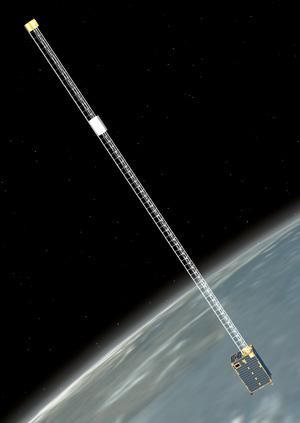Orsted (original) (raw)

Home - Search - Browse - Alphabetic Index: 0- 1- 2- 3- 4- 5- 6- 7- 8- 9
A- B- C- D- E- F- G- H- I- J- K- L- M- N- O- P- Q- R- S- T- U- V- W- X- Y- Z
Orsted
Danish earth magnetosphere satellite.
Status: Operational 1999. First Launch: 1999-02-23. Last Launch: 1999-02-23. Number: 1 . Gross mass: 62 kg (136 lb). Height: 8.00 m (26.20 ft).
Ørsted, the first Danish satellite, carried five science instruments with the objective of mapping the Earth's magnetic field and measuring its associated high-energy charged particle environment. Data from the mission was used to improve geomagnetic models, study the auroral phenomena, and complements data taken by the Magsat spacecraft in the late 70's-early 80's.
Ørsted was gravity gradient stabilized using a deployable 8 meter instrument boom. Magnetic torque coils maintained yaw to within 10 degrees. Attitude determination was via a star camera, with sun sensors and magnetometers as backup. 5 body mounted solar panels with GaAs cells provided 54 watts average power (EOL). NiCd batteries provided power in eclipse. Position determination was provided with GPS receivers: a single-band 6-channel TANS receiver from Trimble, and a dual-band 8-channel GPS TurboRogue from JPL, with a resolution of 50 meters or better. Command and control was via two 80C186 processors. On-board storage of 13 hours of science data was possible. The S-Band communications with a maximum data rate of 256 kbps used cross-dipole antennas.
The Overhauser proton-precession magnetometer measured the scalar values of the magnetic field with a resolution of < 1 nT. A CSC fluxgate magnetometer measured the vector values of the magnetic field with a resolution of < 3-5 nT. Six particle detectors measured high-energy charged particles: electrons (30 KeV to 1 MeV), protons (200 KeV to 30 MeV), and alpha-particles (1 to 100 MeV). The Star Imager determined the absolute attitude of the CSC fluxgate magnetometer with a resolution of < 20 arc-seconds. A GPS TurboRogue dual frequency receiver, with a position accuracy of 5-10 cm, allowed occultation measurements to determine temperature and electron density properties. The two magnetometers and the star imager were placed on an 8 meter deployable boom. The particle detectors and the GPS TurboRogue were mounted on the main spacecraft.
The spacecraft was named after the Danish physicist Hans Christian Ørsted who discovered electromagnetism in 1820.
NASA NSSDC Master Catalog Description
This spacecraft was named after the Danish physicist Hans Christian Oersted (1771-1851), who discovered electromagnetism in 1820. The spacecraft primary science objectives were to perform highly accurate and sensitive measurements of the geomagnetic field and to perform global monitoring of the high energy charged particle environment.
The instrumentation consisted of two magnetometers (proton precession and fluxgate), a star imager for attitude determination, a solid-state charged particle detector package, and a GPS receiver. The Science Instrument Team is responsible for the design of the instruments, while the Science Team is responsible for the science mission planning and international science participation. The science data obtained during the planned one-year mission will be used to derive an updated model of the geomagnetic field and its secular variation and to study the magnetospheric field-aligned currents and their relationship to ionospheric and solar wind conditions.
The principal research topics are in two areas: (1) studies of the generation of the magnetic field in the fluid core and the magnetic and electrical properties of the solid earth; and (2) studies of earth's magnetic field as the controlling parameter of the magnetosphere and of all the physical processes that take place in the earth's plasma environment, including phenomena like aurora and magnetic storms.
To utilize the Oersted science data return, the plan is to establish an internationally recognized research environment in the field of solar-terrestrial physics, a Solar-Terrestrial Physics Laboratory, comprising magnetospheric, ionospheric, and atmospheric physics in combination with research in the magnetic field of the earth. Correlative studies will be carried out using observations from existing monitoring stations in Greenland and other polar regions.
The spacecraft was launched as an auxiliary payload into a near-sun synchronous elliptical polar orbit, with inclination about 96 degrees, perigee/apogee of about 630/850 km, and nodal drift rate 0.76 degree/day. It is gravity-gradient stabilized, with its extendable 8-m boom aligned to and pointing away from the center of the earth. Active attitude control is achieved using three-axis magnetic torqueing coils. The data system features on-board monitoring and pre-processing. Data is stored in a 16-Mbyte on-board memory and downlinked in packetized format when a ground station is in view. The Oersted homepage is located at:
http://www.dmi.dk/fsweb/Projects/oersted/
Family: Earth, Magnetosphere sat, Medium earth orbit. Country: Denmark. Launch Vehicles: Thor, Delta, Delta 2 7000, Delta 7920-10. Launch Sites: Vandenberg, Vandenberg SLC2W. Agency: CRI. Bibliography: 2, 6.
Photo Gallery
 |
Oersted satellite |
|---|
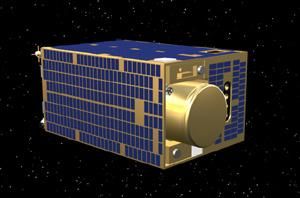 |
Orsted Deployment 1Orsted Boom Deployment - Step 1 |
|---|
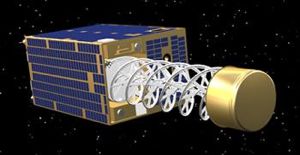 |
Orsted Deployment 2Orsted Boom Deployment - Step 2 |
|---|
 |
Orsted Deployment 3Orsted Boom Deployment - Step 3 |
|---|
 |
Orsted Deployment 4Orsted Boom Deployment - Step 4 |
|---|
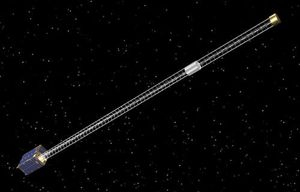 |
Orsted Deployment 5Orsted Boom Deployment - Step 5 |
|---|
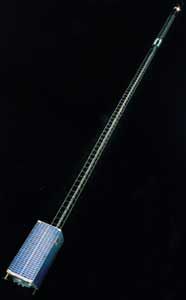 |
OrstedCredit: Manufacturer Image |
|---|
1999 February 23 - . 10:29 GMT - . Launch Site: Vandenberg. Launch Complex: Vandenberg SLC2W. LV Family: Thor. Launch Vehicle: Delta 7920-10.
- Orsted - . Mass: 62 kg (136 lb). Nation: Denmark. Agency: DMI. Manufacturer: CRI. Class: Earth. Type: Magnetosphere satellite. Spacecraft: Orsted. USAF Sat Cat: 25635 . COSPAR: 1999-008B. Apogee: 839 km (521 mi). Perigee: 638 km (396 mi). Inclination: 96.50 deg. Period: 99.60 min. Denmark's Orsted gravity gradient stabilised satellite was to map the Earth's magnetic field. It was managed and operated by the Danish Meteorological Institute in Copenhagen. The satellite's prime contractor was CRI , Copenhagen..
Home - Search - Browse - Alphabetic Index: 0- 1- 2- 3- 4- 5- 6- 7- 8- 9
A- B- C- D- E- F- G- H- I- J- K- L- M- N- O- P- Q- R- S- T- U- V- W- X- Y- Z
© 1997-2019 Mark Wade - Contact
© / Conditions for Use
